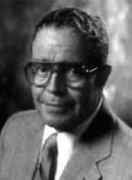Person: Wilkins (2), J. Ernest

J Ernest Wilkins was an African-American mathematician and nuclear scientist. He worked on various pure mathematical topics as well as researching in nuclear engineering and optics.
Mathematical Profile (Excerpt):
- Wilkins entered the University of Chicago in 1936 when only 13 years old and in so doing he became the youngest ever student at that university.
- Few teenagers can have won a scholarship and studied at the Institute for Advanced Study in Princeton but this is exactly what Wilkins did in 1942 with a Rosenwald Scholarship.
- They are The first canonical pencil and A special class of surfaces in projective differential geometry both published in Duke Mathematical Journal.
- In the second he considers a certain class of surfaces and expresses characteristic properties of these surfaces in terms of standard projective elements.
- In 1943-44 Wilkins taught at the Tuskegee Institute, where most of the students were black.
- He then returned to the University of Chicago where he worked on the Manhattan Project in the Metallurgical Laboratory from 1944 to 1946.
- Wilkins continued to produce a remarkable number of mathematical papers on a wide variety of different topics.
- In 1944 four of his papers appeared: On the growth of solutions of linear differential equations; Definitely self-conjugate adjoint integral equations; Multiple integral problems in parametric form in the calculus of variations; and A note on skewness and kurtosis.
- After leaving the Manhattan Project in 1946, Wilkins worked in industry.
- It was during this time that Wilkins earned himself further degrees when he was awarded a Bachelor of Mechanical Engineering from New York University in 1957, and a Master of Mechanical Engineering three years later.
- After this Wilkins held a number of academic and non-academic appointments.
- From 1977 to 1984 Wilkins worked at EG&G Idaho, becoming Vice President and Deputy General Manager for Science and Engineering.
- We have looked above at some of the pure mathematical topics which Wilkins looked at early in his career.
- This technique of calculating radiative absorption is widely used among researchers in space and nuclear science projects.
- Other work which he has done has been related to heat transfer and in January 1992 he was invited to give a joint American Mathematical Society - Mathematical Association of America lecture in Baltimore, Maryland.
- A member of the National Academy of Engineering who received his doctorate in mathematics from the University of Chicago at the age of nineteen, Wilkins has worked in academia, industry, and government.
- In the interview, Wilkins describes some of the mathematical problems he has worked on and discusses some of the difficulties in trying to improve the participation of members of underrepresented groups in science and mathematics.
- Wilkins examines the mathematical aspects of determining the optimal shape of such fins.
- Wilkins has received a large number of honours for his work.
Born 27 November 1923, Chicago, Illinois, USA. Died 1 May 2011, Fountain Hills, Arizona, USA.
View full biography at MacTutor
Tags relevant for this person:
African American, Origin Usa
Thank you to the contributors under CC BY-SA 4.0! 

- Github:
-

- non-Github:
- @J-J-O'Connor
- @E-F-Robertson
References
Adapted from other CC BY-SA 4.0 Sources:
- O’Connor, John J; Robertson, Edmund F: MacTutor History of Mathematics Archive
